Game Designers: Amy Lo, Shimea Bridgewater
Overview
In the world of “Time Travel Arcade”, you and your friends are the owners to an unsuccessful arcade in the year 2023. Each of you believe you have what it takes to run a successful arcade, but think each other is holding you back. Bored without customers, you all play your favorite game in your empty arcade and realize you’ve stumbled across a time machine! You and your friends have traveled back to the 70’s, when arcades began. While trying to travel back home to the present with your buggy time machine, you all decide to compete on who can make the most successful arcade while making your way home.
“Time Travel Arcade” is a game to teach about arcade game history and the difficulties that arcades face while staying profitable as the game industry advances in time for 4-6 players Players compete against each other to maximize their profit as arcade business owners while being one of the first three players to make it to the end of the game and make it back home to the present. Along the way, players collect money to purchase game cards from their respective decades and sell them to use special abilities to get ahead of other players.
Similar Games
We modeled our game off of four similar games:
- Chutes and Ladders: Dramatic rises and falls in the board layout
- Monopoly: Money management and purchasing power throughout the game
- The Game of Life: Rewards players with money for “Pay Days” as they move through life and embed event descriptions along the board path
- Senet: An ancient Egyptian game that uses forward and backward movements in gameplay
Final Game
Required materials: Game Rules and Print and Play PDF
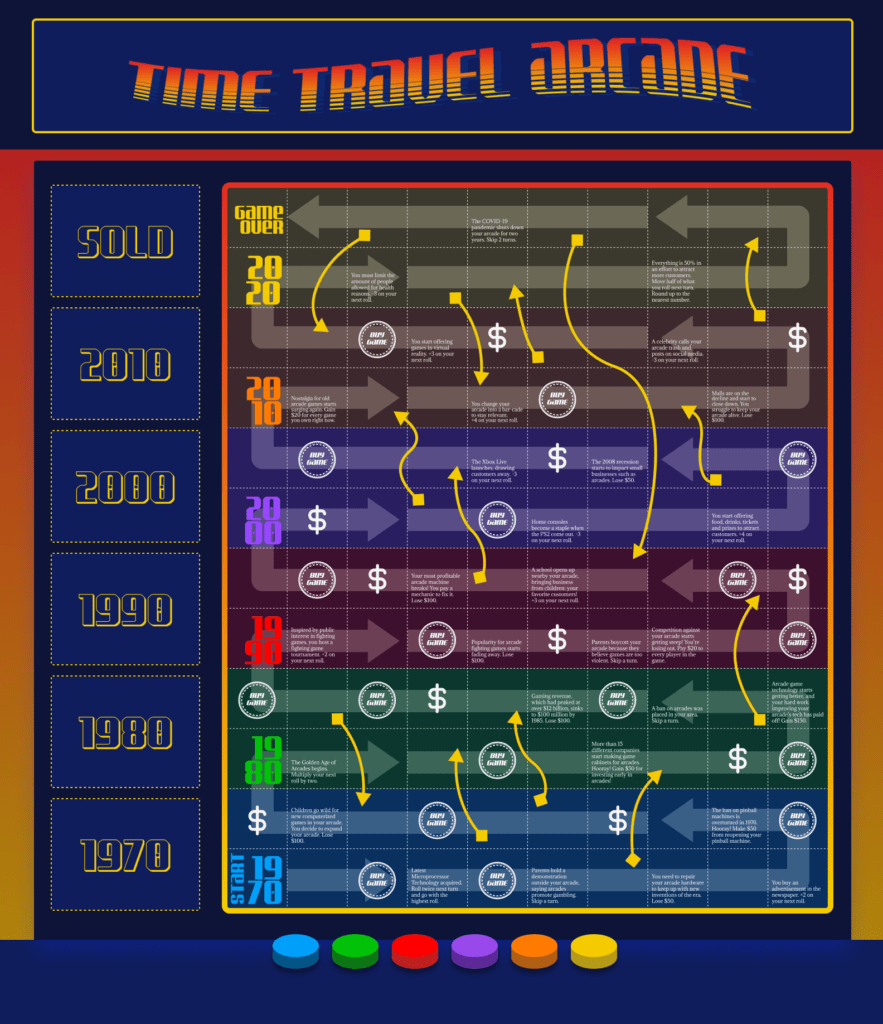
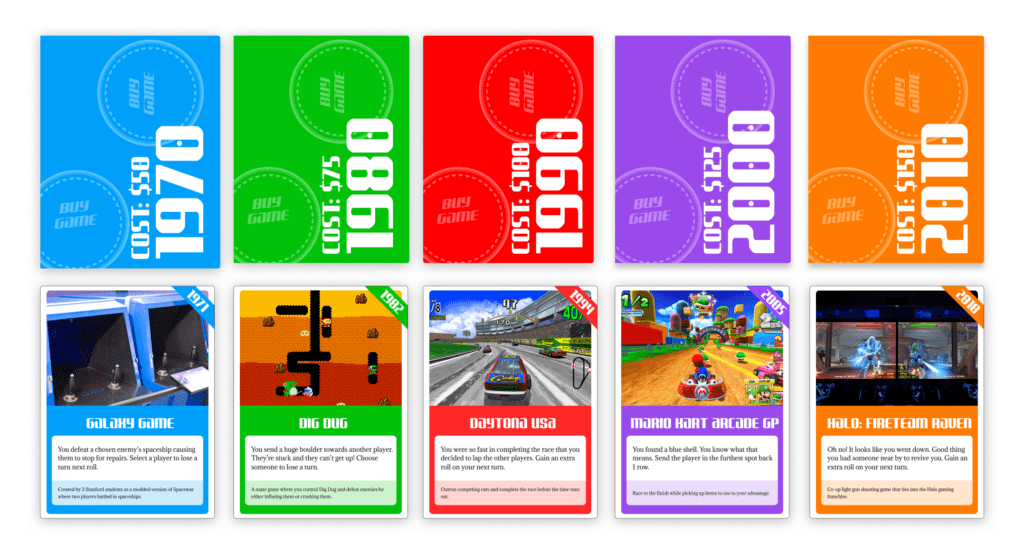

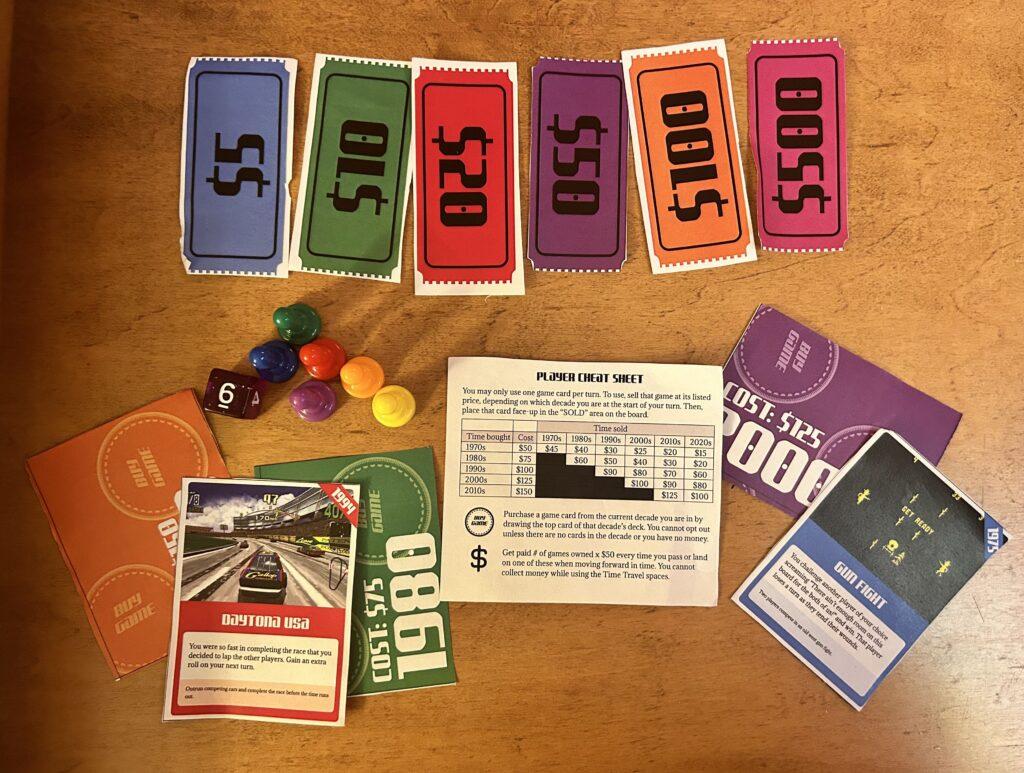
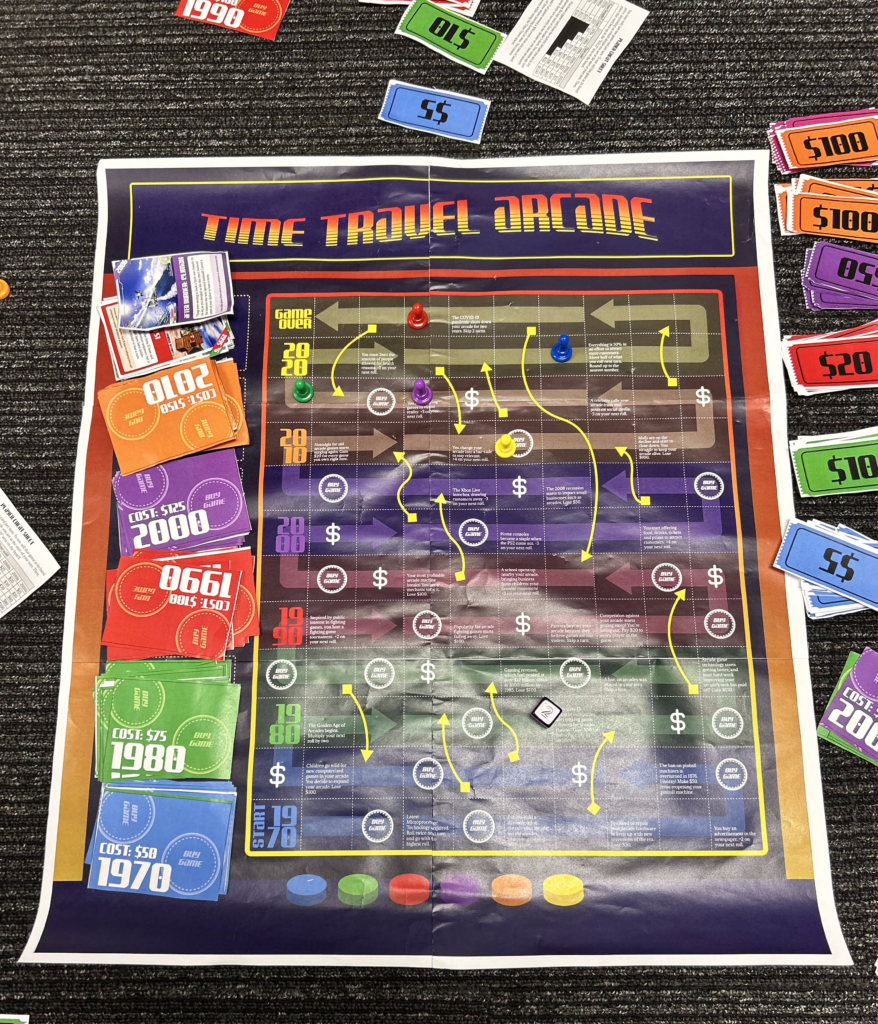

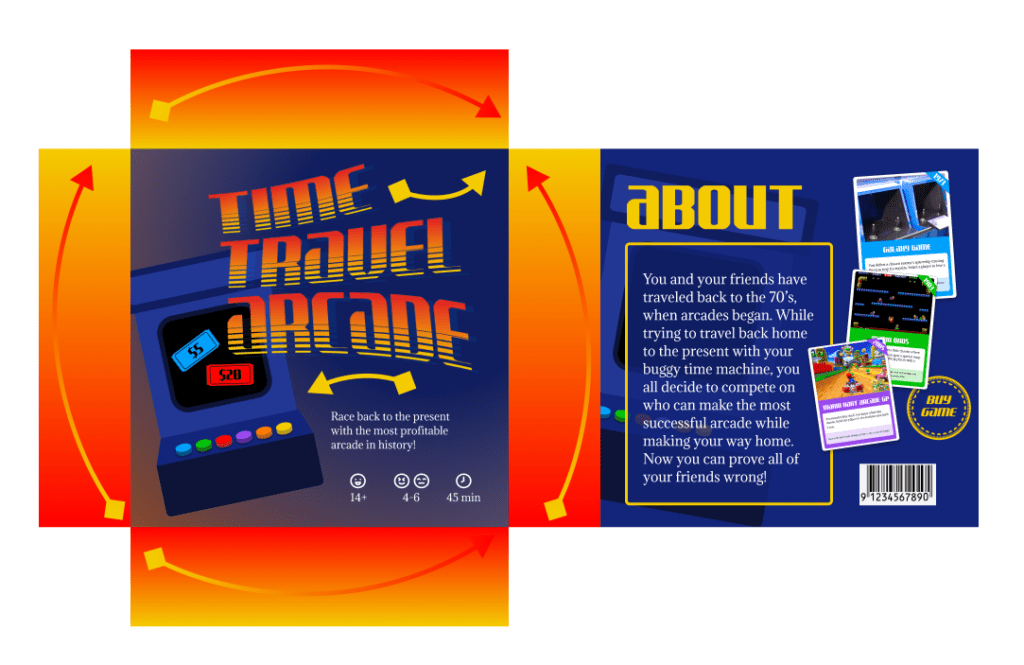
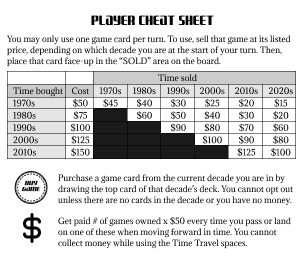
Types of Fun
The core types of fun in our game were challenge, fellowship, and sensation.
Challenge was elicited through the game acting as an obstacle course to players – players have to dodge harrowing time travel arrows moving them back and forth in time. We succeeded in evoking frustration in players when they landed on spaces in the board that caused them to lose money or purchase games. Additionally, we also took away agency for players by forcing them to purchase games on “Token” spaces. Games depreciate in price as time moves forward in the games. This caused players to fluctuate multiple constraints:
- Sell a game early to lose less money, but lose the possibility of a tactical advantage and making $50 per “Pay Day” spot you pass
- Sell a game later to use its tactical advantage as the game grows in difficulty closer to the end, but lose more money from not selling it earlier
As a social party game, “Time Travel Arcade” demonstrates fellowship. Players are pitted against each other and take actions to block other players’ movements through game card abilities. We often heard play noises during our testing sessions, such as “Oh no!” when players time traveled backwards in the board and lost money or happy exclamations when players made money, set back their opponents, bought a game, or time traveled forwards.
Lastly, our game illustrates sensation. Sensation through game bits such as rolling the die, making and losing money, and the joy of receiving a new game also helped evoke emotions in our game. The physical sensation of rolling a die contributed to the fun of our game. A funny anecdote from our last playtest was one of our players started to superstitiously blow on the dice before rolling for better luck. Players also liked the sensation of getting game cards, comparing them to collector’s cards and even reading out loud game descriptions and abilities to share with each other.
Learning Outcomes
The learning outcomes of our game were to:
- Help players learn about and discover arcade games from the past
- Demonstrate economic principles around arcade games
- Depict the rise and fall of arcades over time
- Introduce players to important events that affected arcades
Help players learn about and discover arcade games from the past
Through game cards, players are introduced to arcade games throughout history. We varied the number of game cards per decade depending on the relative popularity of arcades at that era, the highest in the 1980s during the Golden Era of arcades. Game cards were intentionally designed to look like collector’s cards matching the nostalgia we experience at arcades, with information such as the game title, description of the game, year released, and a picture of the game. All game abilities also reference key elements of the game on the card, helping players associate the games with their respective mechanics.
Demonstrate economic principles around arcade games
When we researched arcades, we learned that arcades often struggle to keep up with advances in technology around games. Although home consoles have become cheaper over time, arcade game machines have not – becoming more and more expensive over the years as demand for arcade games have gone down. We illustrated this inverse relationship in two ways. First, the price of game cards in our game increases over time. Second, the value of a game card depreciates over time when sold. We wanted players to feel frustration at this relationship and replicate the real-life challenges that arcades face maintaining their arcades to stay competitive.
Depict the rise and fall of arcades over time
Through pace, the board mirrors the rise and fall of popularity for arcades in history. From 1970-1980, time travel arrows mostly point upward to move players forward in time faster, while in the 2000s onward, time travel arrows mostly point down to make gameplay more difficult. Although the game starts slowly, it deliberately is designed to ramp up in the 1980s, when arcades reached their Golden Age in history.
Introduce players to important events and factors that affect arcades
We included historical events that impacted arcades, such as the release of home consoles, the Golden Age of Arcades, and the COVID-19 pandemic. Additionally, we wanted players to learn about factors that affect arcades as small businesses – repairing machines, advertising locally, malls closing down, and parent protests of arcades. To mirror these real-life events, we offered rewards or punishments to players depending on the affective value of the event.
History of Iterations
Playtest 1: Senet-inspired Game (2 players, 1 observer)
For this playtest, as we still weren’t sure of which mechanics would work best in thoughtfully achieving our learning objectives, we decided to use this playtest to test out different mechanics. We included things like “swirlys” which acted as event cards that could affect the player. We also had the dice mechanic to determine how much a player should move. The dynamics we liked most that came out of this playtest was the strategy players had to use to not only win the game, but also keep their opponent from winning.
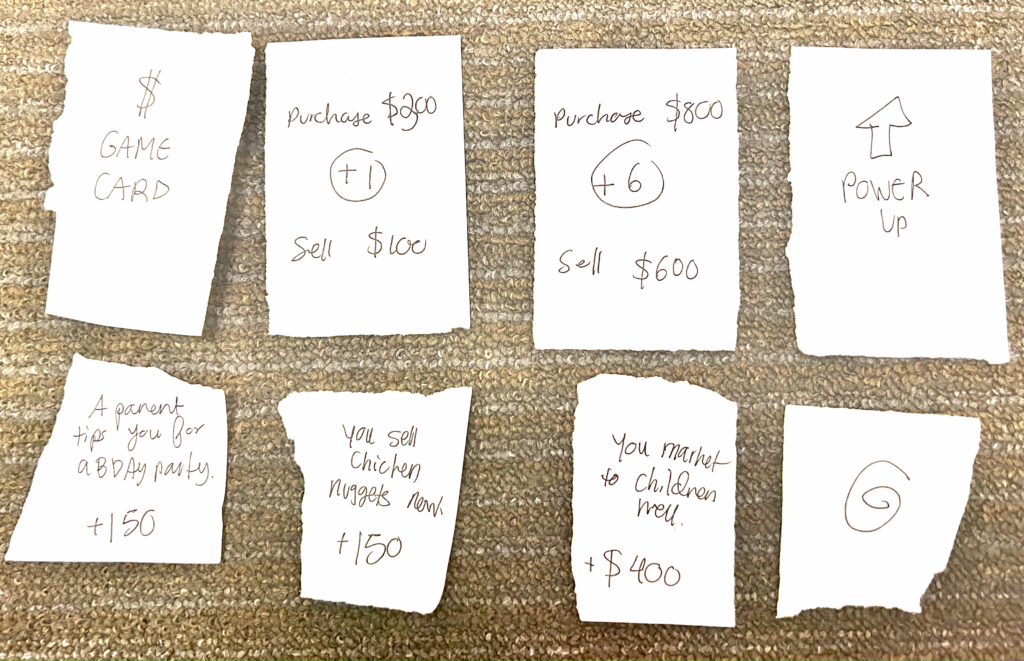
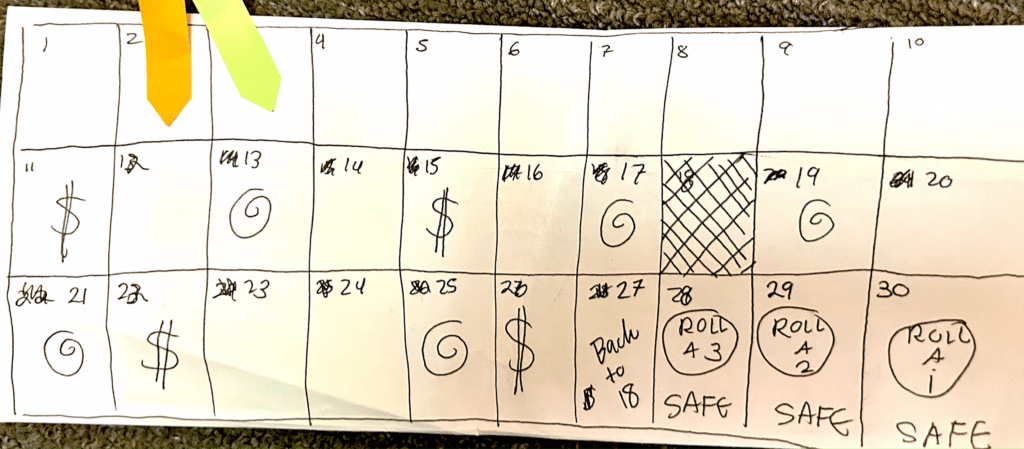
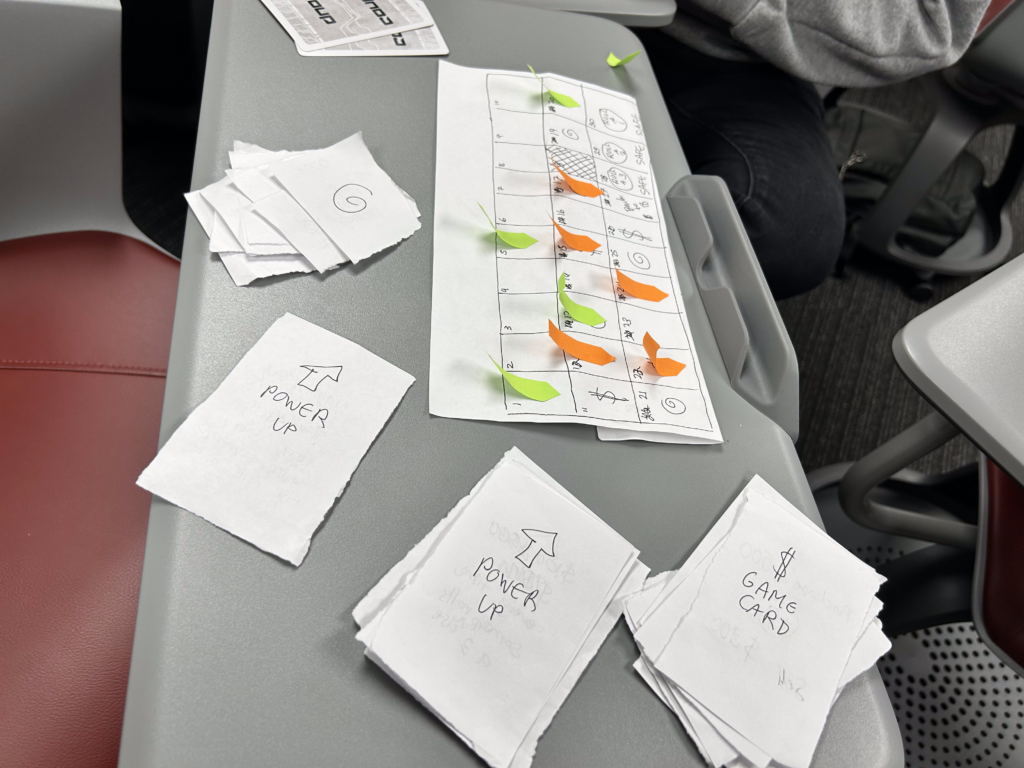
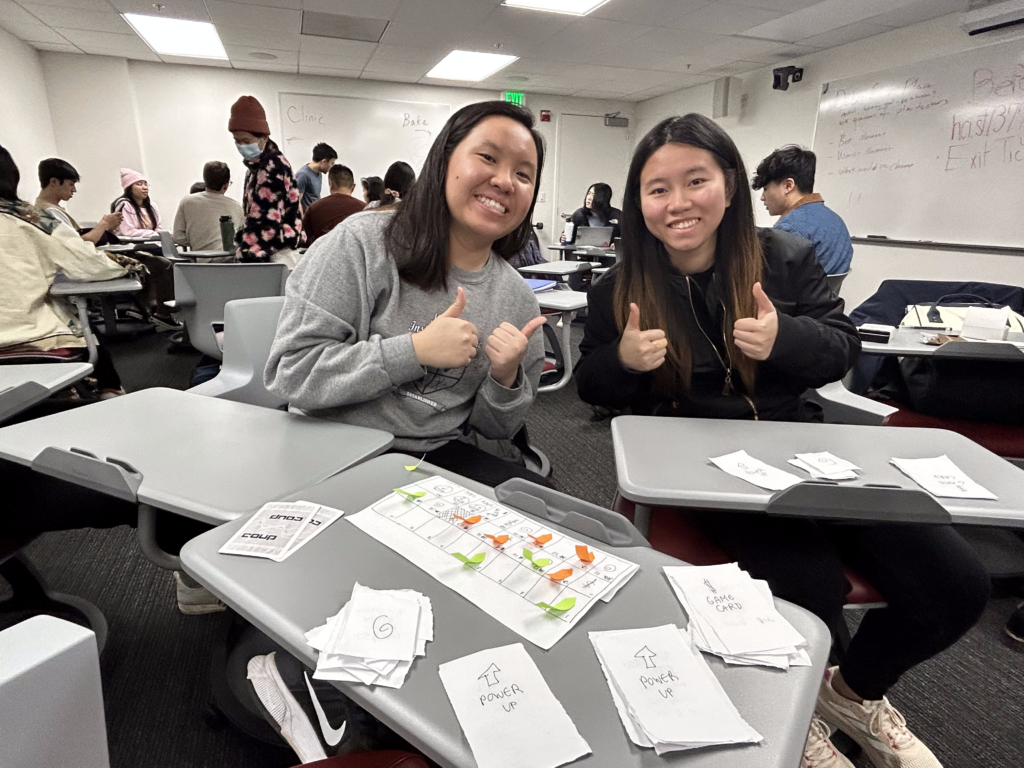
Observations
- Players showed some confusion with the rules
- Heard lots of play noises because of the power ups and swirly obstacle cards
- Both players felt like there was no reward for getting their game pieces off the board
- No motivation to end the game
- “There’s no inherent bonus for getting my pieces off the board”
- Both players liked the swirlys and the events they brought forth.
- “It made me wonder what’s going to happen to my business next.”
Changes we made
- Make it a game for 4 players instead of two which includes having players only control 1 game piece instead of multiples
- Create an obvious separation of decades
- Have “Game” cards for each decade where the card holds a game from that decade
- Similarly have event spaces on the board that introduces something that actually happened in that time that had some effect on the Arcade industry
- In regards to the “Game” cards mentioned above:
- Each card will have a game that is from the decade you pick it up in
- Each card also comes with an ability related to that game
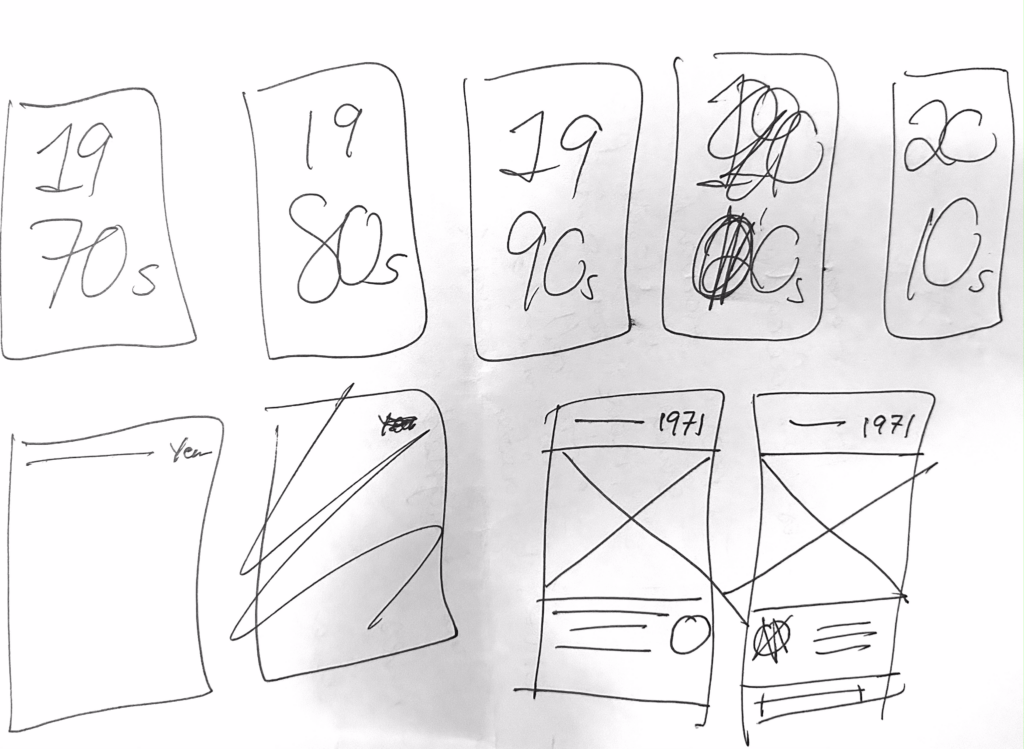
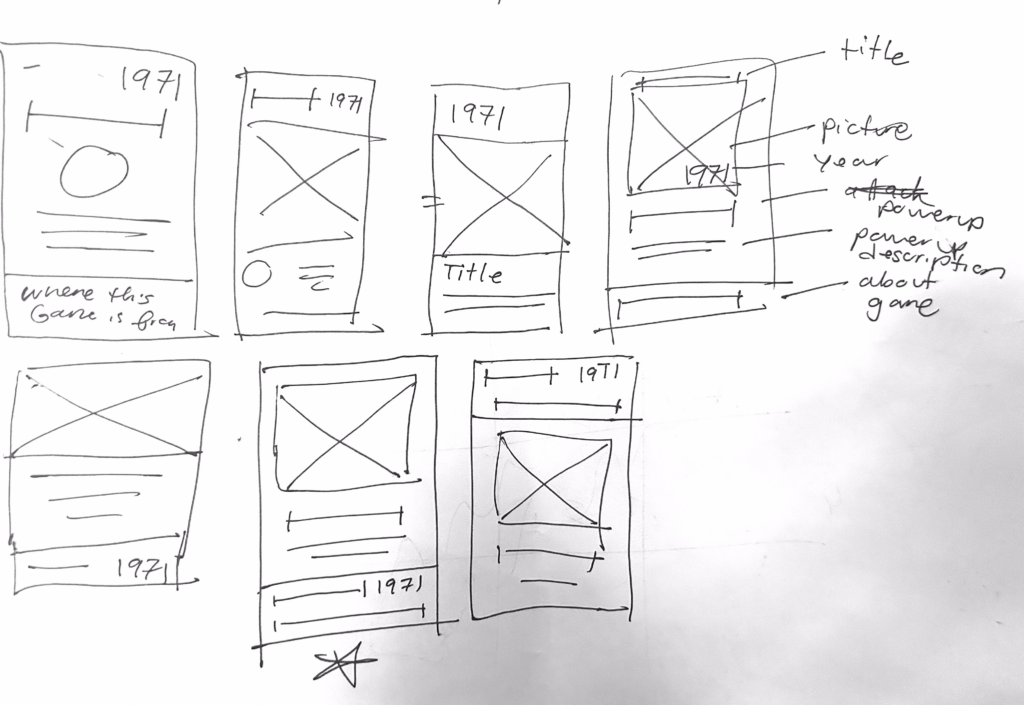
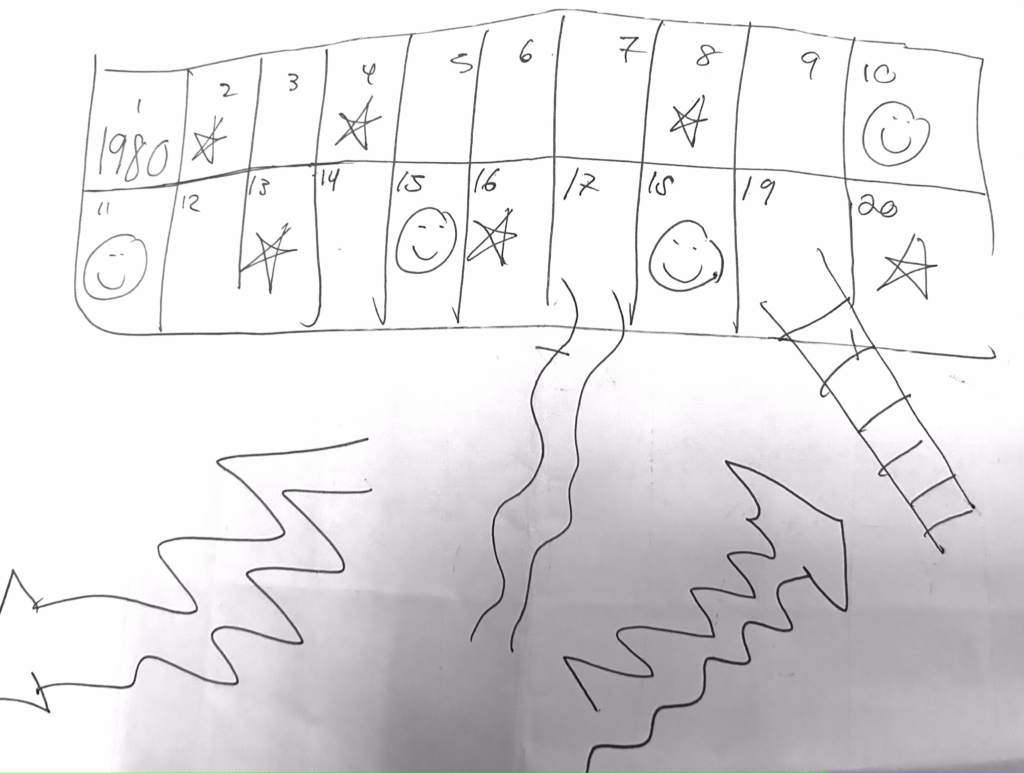
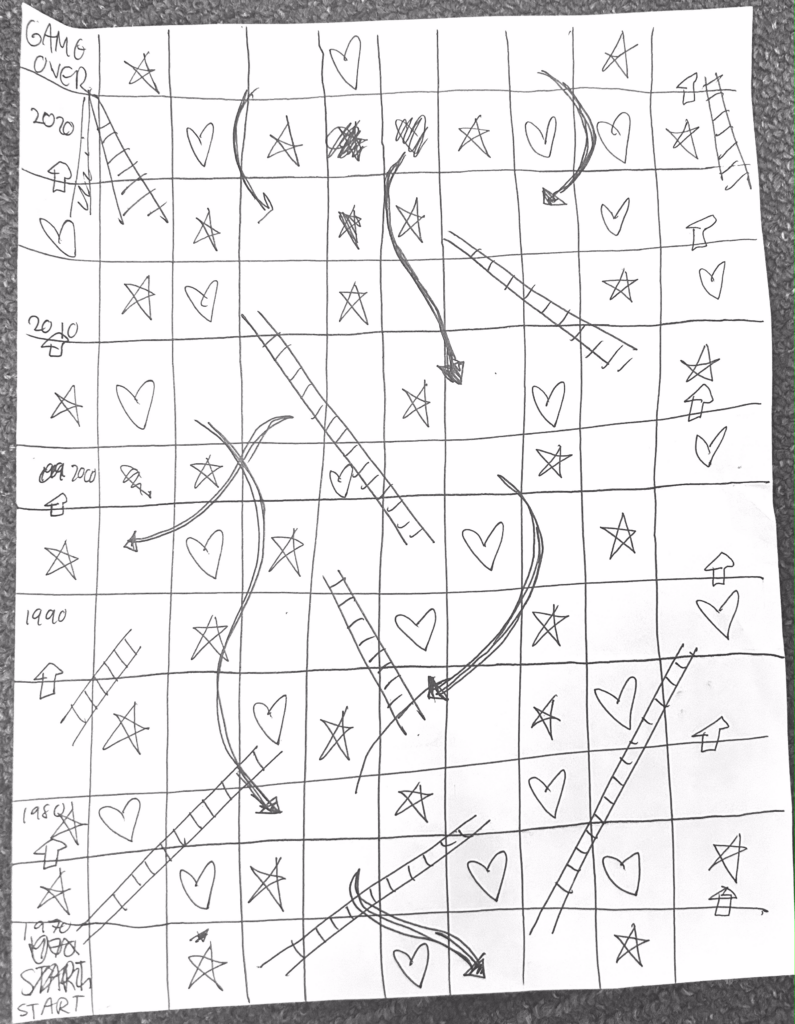
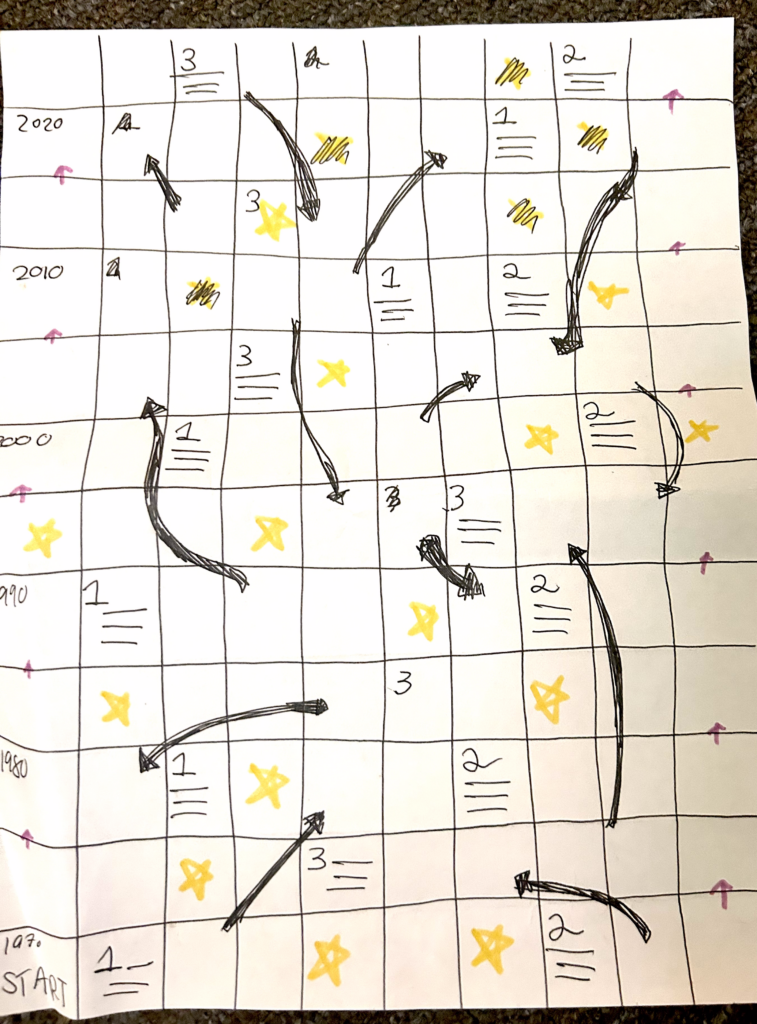
Playtest 2: Time Travel Arcade V1 (4 players)
This is the playtest where we started to really get an idea for how the game would play. We completely remodeled our board, taking inspiration from Chutes & Ladders and created that clear separation of the decades to reinforce the idea that the players are traveling through time. The biggest takeaway from this playtest is that players felt like there could be more interactions between each other. They didn’t have any real incentive to use their game card abilities which led us to introduce an economy in the hopes of encouraging more use of these abilities.
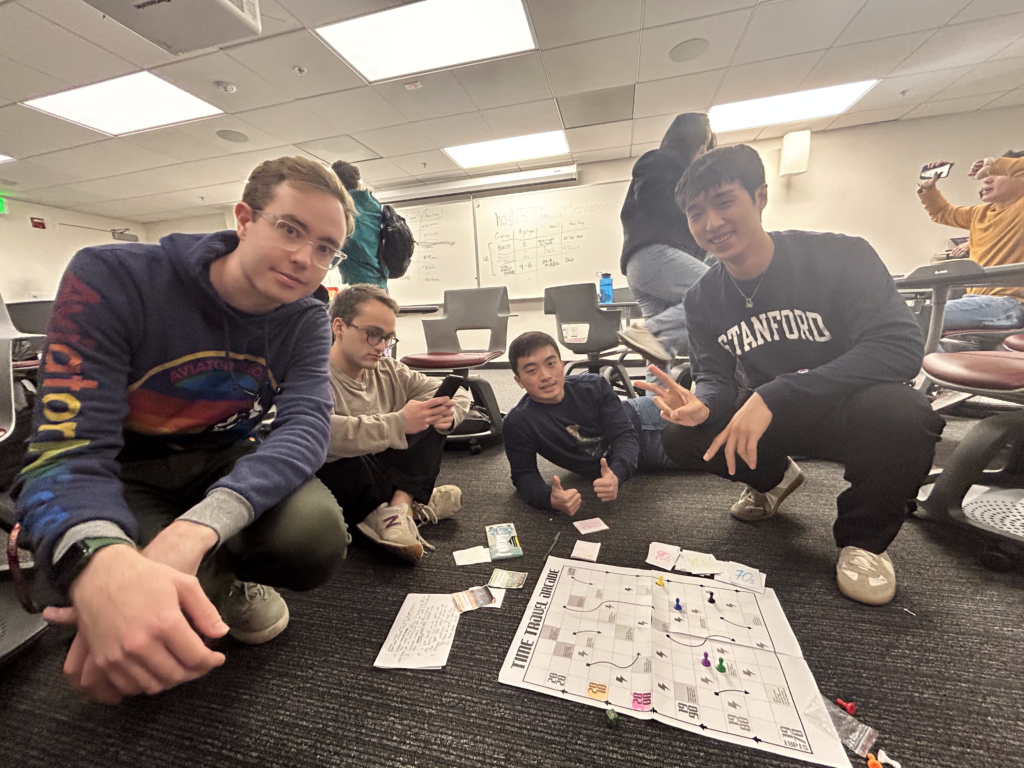
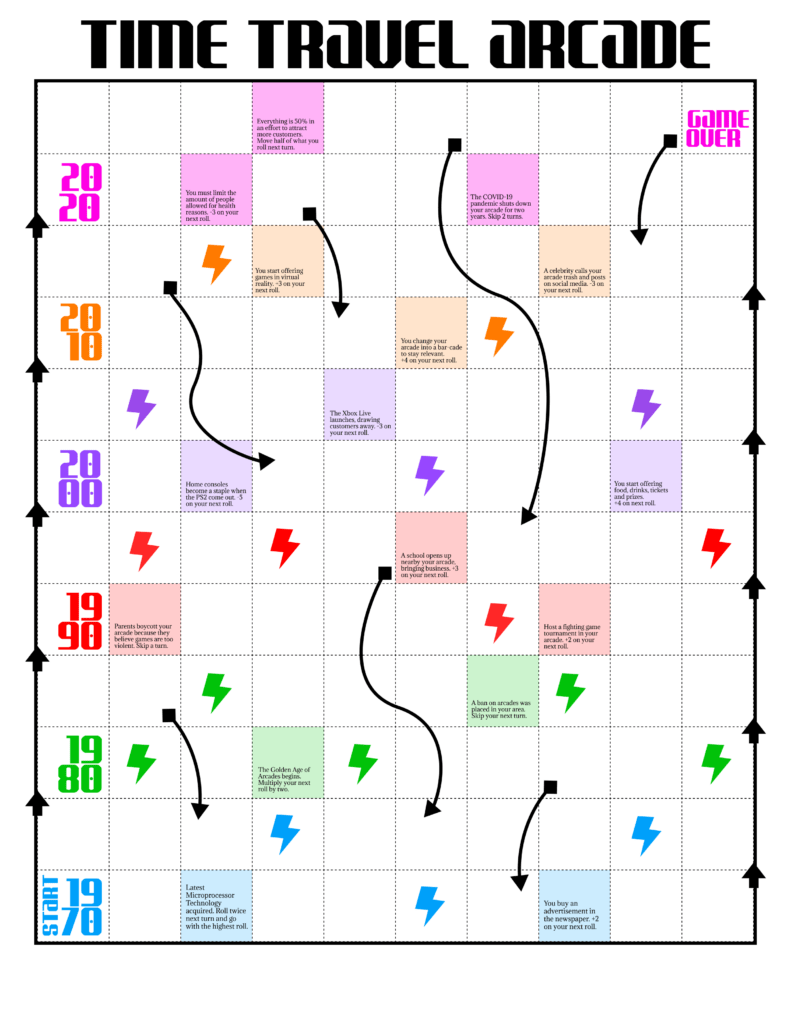
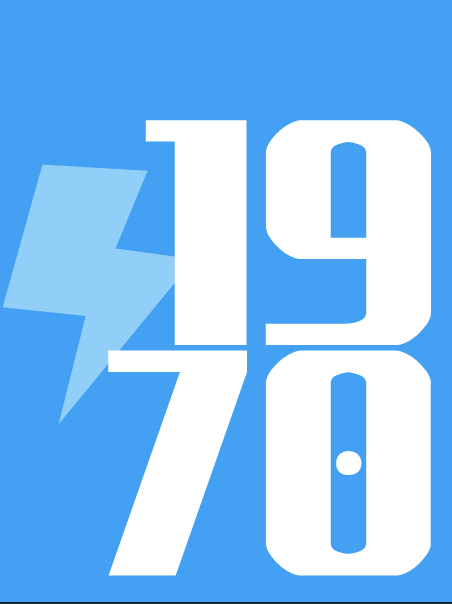
Observations
- Not enough chances to purchase games
- They liked reading out the cards (with context)
- Game noises towards cards, being sent back, and events
- Hard to read board if you’re on the other side
- Found difficulty in understanding how they should move around the board
- Found difficulty with keeping track with what decade they were in
- Wanted “ladders” or spaces that take them up
- Threw around ideas to include different dice sizes
- Wanted more interaction between players
Changes We Made
- Introduced a money system to the game
- All decades got a base buy and sell price and also how much money players collect for owning a number of games
- The sell price goes down each decade to encourage use of game cards earlier
- In order for players to use their game card ability, they now have to sell their game
- Need a way for players to collect money
- With the addition of money, we included events related to it
- Goal of the game was changed
- Person with the most money at the end wins
- Since there is still a race to the finish aspect, we rewarded the first 3 players who makes it there first
- Added some up arrows
- With the addition of warps that go up, other players won’t be able to prolong the game extensively, the game must end
Playtest 3: Time Travel Arcade V2 (4 players)
We believe this playtest was one of our most successful in terms of achieving our learning goals. At the end of the playtest, when we asked players what they learned, we heard responses like “I didn’t know there were so many games”, “The historical events were exciting”, and “I liked the little factoids on each game card” which was really encouraging to hear. With the addition of money, we wanted to test how players interacted with money for games. Additionally, we observed players’ strategies and how they changed over time. We were really excited to see that we achieved our ideal effect through the mechanics of our game, as players expressed play noises and started theorizing on how they could adapt to the different decades. We also tested our rulebook for the first time without input from us as moderators.

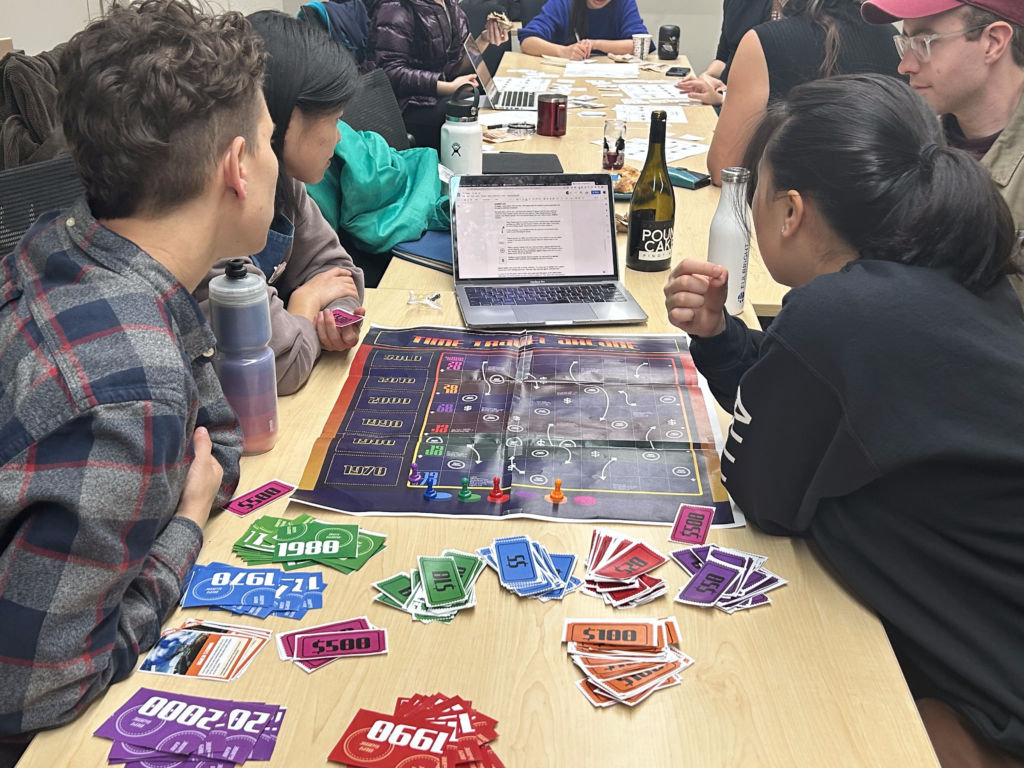
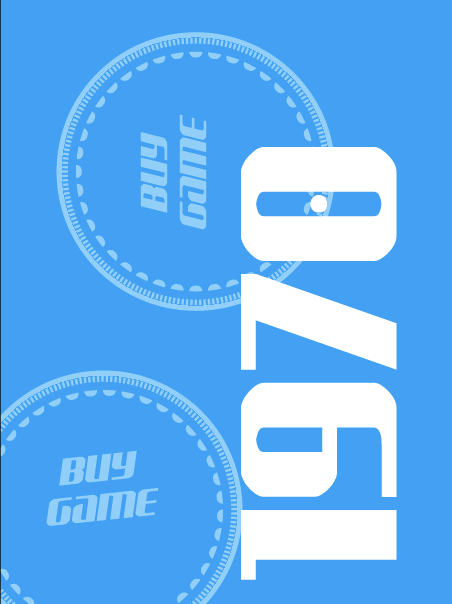
Observations
- Players naturally put their player tokens on the buttons of the bottom. We thought this was cute, so we updated the flow of the board to match!
- Still some confusion on how to move around the board
- Players felt it made sense that if you sold a game in the same decade it was bought, you would make the most money
- Confusion with certain spaces on the board like the collect spaces
- Players started to think of different strategies
- If a player was close to a collect space, they would wait to sell their game until after they passed that collect space, in order to receive the max amount of money
- One playtester suggested having some games from popular franchises especially appreciate in value instead of depreciate
- Players thought the game was too slow and should include more arrows that warped them up
Changes We Made
- Flipped most of the down arrows to be up in the hopes of speeding up the game
- Updated the rulebook describing more tricky and specific mechanics of the game
- Adding more collect spaces to the game
- Added arrows on the board to show the directions moving forward
- Tried to hint players toward strategies in the rules
Playtest 4: Time Travel Arcade V3 (6 players)
In this playtest, we tested a refined version of our game, continuing to modify arrows and add spaces to the board. We wanted to see how different arrows to time travel would impact the play of the game. What was most impactful in this playtest was figuring out which arrows players liked interacting with the most!
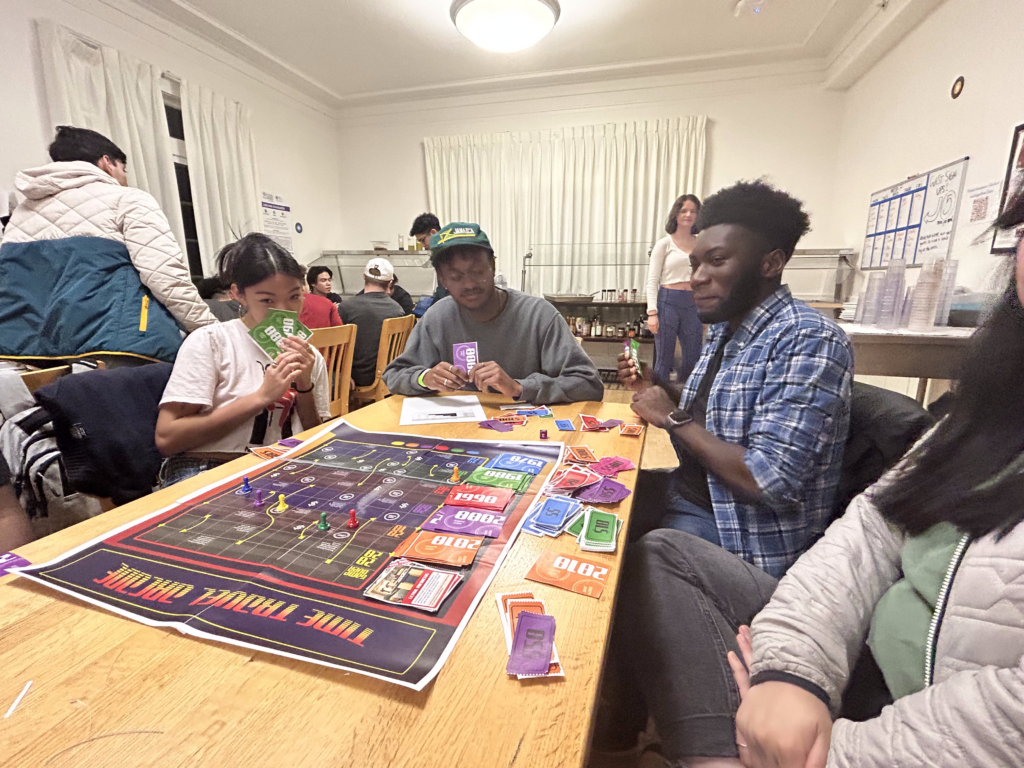
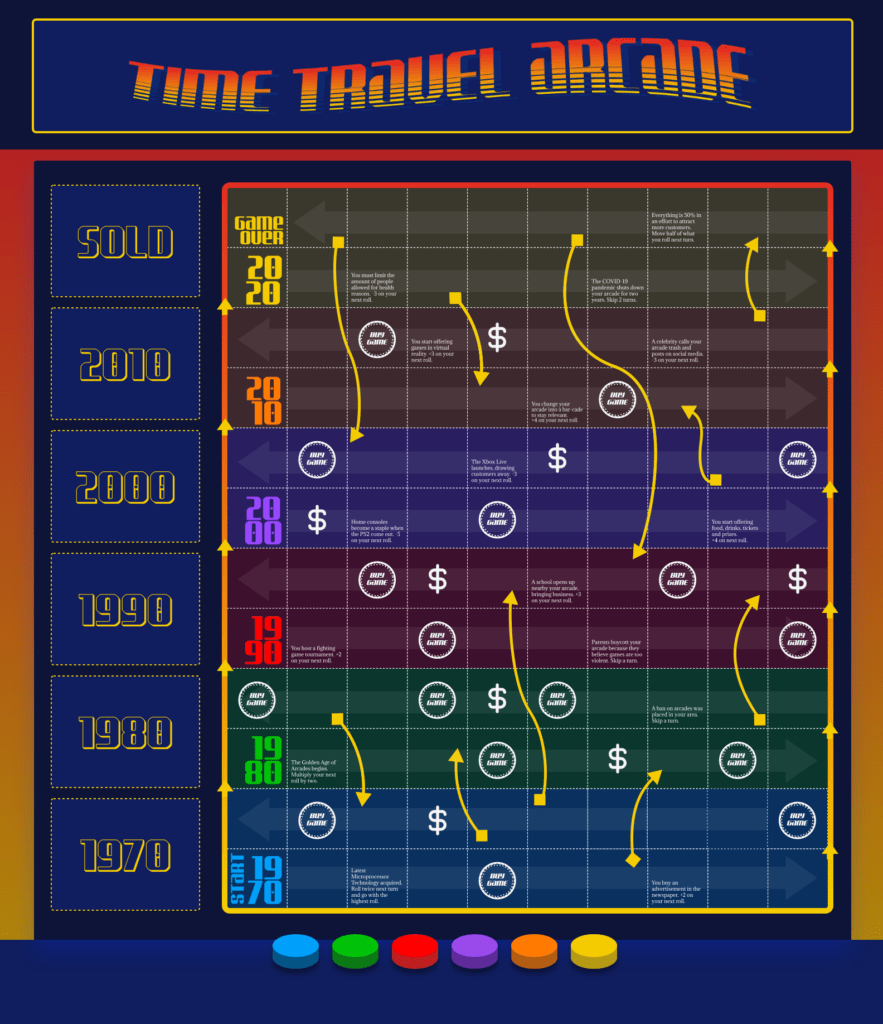
Observations
- Players wanted more opportunities to buy games
- Up arrows on the board’s border confused players’ movement (“Can I move diagonally?”
- The arrows on the board were too faint and players couldn’t read them
- Players had confusion about when they could play a game card
- Some of the arrows felt too harsh (arrow on the last spot before “End Game”)
- Players had high reactions (“Wait, I’m poor! When did this happen?” but gameplay was too long, around ~1 hr
- Players started to strategize around 1990, as we wanted them to, maximizing profit through decision-making: “It’s gonna be worth the most now so you should sell now”
Changes We Made
- Removed the up arrows on the side of the board
- Increased the opacity of the horizontal left and right arrows moving gameplay
- Updated the rules to reflect where items should be placed on the board
- Added more opportunities to purchase games
- Added more up arrows at the bottom of the board
- Reduced the severity of down arrows on the board
Playtest 5: Time Travel Arcade V4 (4 players)
In a rapid iteration, we tested this version of our game after an hour of changes. We made modifications to the arrows of our game from the previous playtest and removed distracting elements from the last playtest. This playtest inspired us to create more opportunities for players to engage with each other and the board, as well as make cheat sheets for players to reference instead of continuously checking the rules.
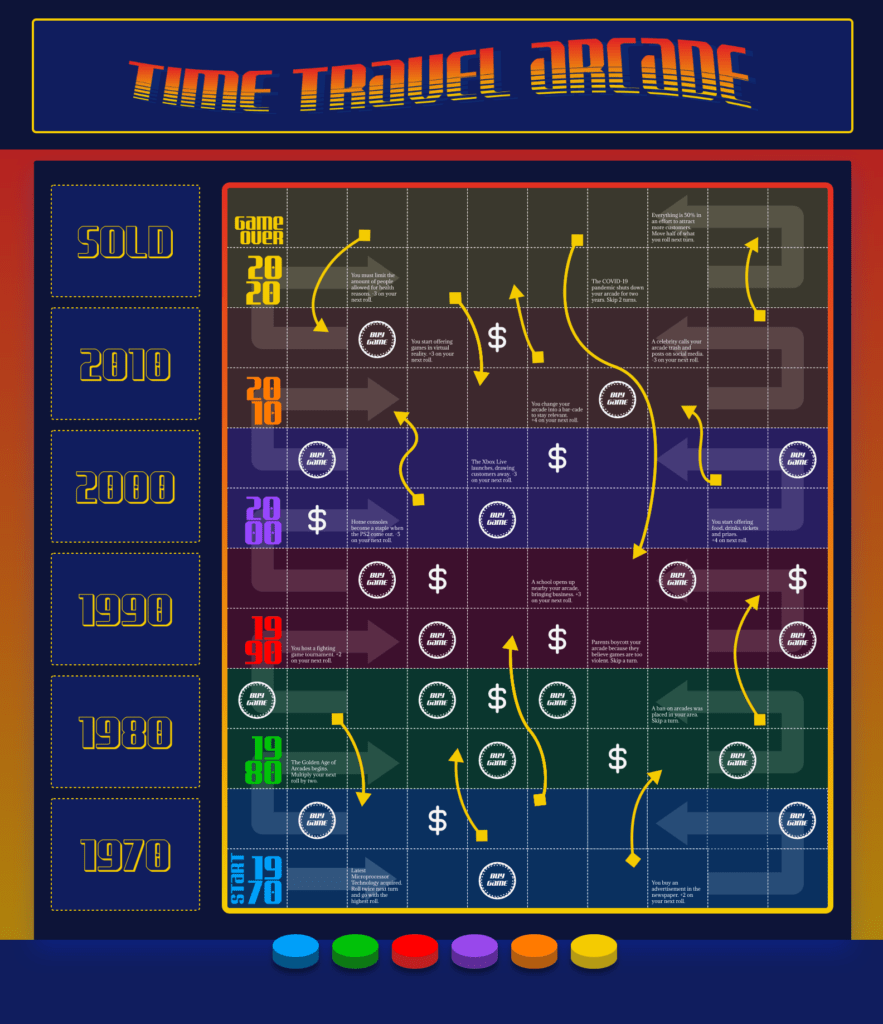
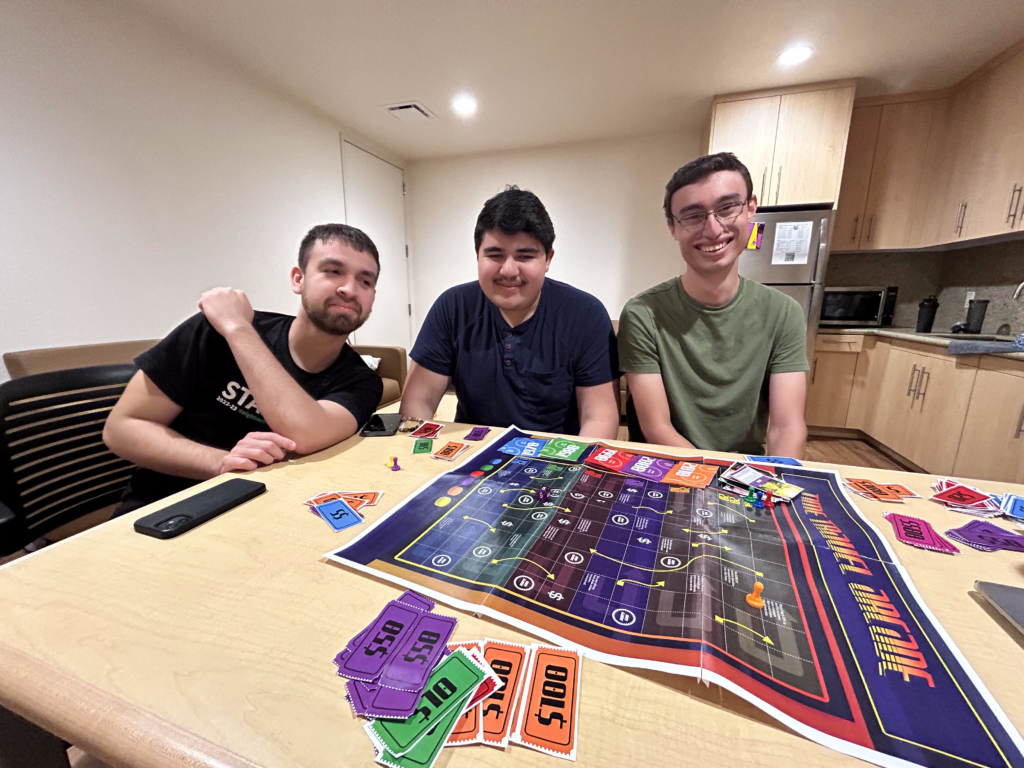
Observations
- Players wanted more events earlier in the game to learn about history of games
- Confusion about some game tiles (“Do I round up or down here?”)
- Players liked the new arrows, but wanted them to be more visible
- Players wanted more interaction on the board
- “It would be cool to add tiles where the player has to pay for something!”
- “Add places where you can take $ from another player”
- “There were times where you can roll around where nothing happens”
- Players had to keep double checking the rules for buy and sell rates
Changes We Made
- Add the price of the card on the back of the card, so that it’s visible when the cards are placed on the board in their decade decks. We wanted cards to be placed horizontally with the price and work both vertically and horizontally when held in hand.
- Added more historical references to events in arcade history
- Added opportunities for players to take money from each other, gain money from the board, and lose money from the board
- A suggestion that we took from players was creating a U-turn like graphic on our board to demonstrate the snaking directions of our board
- Created player cheat sheets with key actions in the game and the prices to buy and sell games
Playtest 6: Time Travel Arcade V5 (6 players)
As this was our final playtest in class we simply handed the game over to players and watched it all unravel. While it was hard being a pure spectator of the game, we do think it brought incredible insight on areas of the game that could still be improved if given more time.
Observations
- In the beginning there was a lot of confusion on different aspects of the game, like how to win, but as the players continued to play, they eventually gained an understanding
- Play noises increased the longer the game went on
- Less confusion on the direction you go compared to past playtests, but there was still some
- One player said they had a hard time staying engaged because they weren’t concerned about other players’ actions
- Felt like the cheat sheet was hard to understand and suggested color coding it
Changes We Made
- Edited the rulebook, placing the objective of the game at the very top
Reflection
This game quickly grew from something simple to something more ambitious and complex. The hardest part was encouraging interactions between players as that was something not only our players wanted more of, but we did too. We thought our inclusion of money and depreciating the values of games the longer you held on to them would encourage the use of the game card abilities. But, with the inclusion of collect spaces we saw players hold on to their games in order to earn the fixed price they would receive depending on the quantity of games in their inventory.
We think that for a future iteration we would need to do some rework on the entire economy. The method we ultimately implemented for money was one in which we thought would be easiest given the time frame, but some things we would have liked to include are:
- Every game has a unique buy price, not sell price as that would be too much to manage for an analog game, and the amount earned on collect spaces differs by decade
- Have certain games, like those from popular franchises, appreciate in value instead of everything depreciates in order to show which games are collector items today and therefore more valued
- Add events that are related to the game cards owned such as being able to advertise your arcade as a vintage arcade in a later decade and reaping the benefits if you have a certain amount of cards from the earlier decades to further show the lengths arcades have had to go through in order to stay relevant
Overall, we are very proud of the Time Travel Arcade and how it has grown these past two weeks. We truly believe this is a game with great potential, it just needs a lot more iterations.



